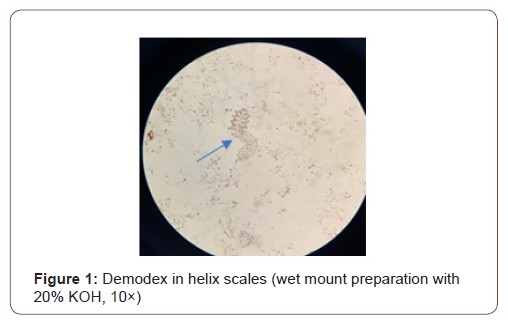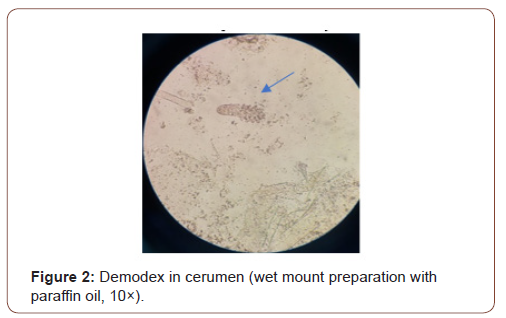Authored by Eduard Vasile Nastase*,
Abstract
While facial skin demodicosis was investigated during the time, ear demodicosis has only few but not to be neglected references. This ear disease should also be included on the list of the differential diagnosis in patients with damaged ears, especially when itching is one of the symptoms.
Keywords: Demodicosis; Demodex; Ears; Itching
Abbreviation: VAS: Visual analogue scale
Introduction
Demodicosis is a parasitic skin disease caused by Demodex folliculorum and Demodex brevis. Usually, D. folliculorum is found in the infundibular portion of the hair follicles, while D. brevis likes sebaceous ducts, Meibomian glands, and the deeper parts of hair follicles. The mites are translucent and worm-like with a head, four pairs of legs, and a longer body tail [1]. The lengths of adult mites reach 0.3-0.4mm [2]. Their mainly nocturnal movements at a rate of 8-16mm/h [3] could explain why the itching is more annoying during this part of the day. The bright light determines the mites to hide into hair follicles [3], which could be an explanation to the reduced number of Demodex forms found when collecting the samples during the day. The meal of these mites includes a cocktail of skin cells, hormones and sebum accumulating in the hair follicles [3].
Clinical Consideration
There are two types of ear demodicosis: Demodectic frost of the ear and Auricular demodicosis [1]. Demodectic frost of the ear was described in an observation to a man in his 50s presenting for routine total body skin examination. He was completely asymptomatic, having frosted, gritty follicular scaling of his ears, superimposed on an erythematous base. Findings from skin scraping followed by potassium hydroxide preparation of the scale were positive for Demodex mites [3]. This demodectic frost of the ear presented fine follicular scaling primarily confined to the helix and lobule, giving the skin a frosted or powdery appearance and sandpaper-like texture. In some patients, there were also reported auricular erythema, pruritus, pain, and discomfort [4].
Auricular demodicosis was described in a case report on an 84-year-old woman, who presented herself for impaired hearing, but was found with chronic pruritic otitis externa, myringitis and a chronic cholesteatoma. Despite failing to establish the cause by microbiological and mycological investigations, histology of the external auditory canal and tympanic membrane revealed a large amount of Demodex mites [5].
In another study from Turkey, 50 enrolled patients were found with itching ears and on 54 health-control patients VAS was used to rate the itch, the itch period, and the medication used for itching. For the first group a positive and strongly significant relationship was observed between the number of Demodex spp. and severity of ear itch, with VAS scores of p=0.0001 and r=0.724 [6]. In another study performed in China on 613 college students, 11.58% were found positive with D. folliculorum and D. brevis. 67.60% from the positive cases complained constant scratching and itch [7]. As more than 5 mites/cm2 are considered pathogenic for the patients with demodectic facial skin illness [8], in the examined studies included in our references we have not found any evidence about the pathogenic threshold number related to ears diseases caused by them.
Discussion
We found only few references in literature regarding to ear demodicosis, showing that it could be masked by others ear illness or mime them, as a possible reason for misdiagnosing the disease. The result may turn into a therapeutic failure and consequently a prolonged evolution of the disease. We highlight that (Figure 1) was taken from a microscopic examination of helix scales sample on a Romanian elderly male patient and was associated with the text to illustrate the observation about demodectic ear frost described. (Figure 2) was taken from a microscopic examination of a cerumen ear sample of another Romanian old man to illustrate the auricular demodicosis, even if the sampling method is different (in the case report the histological sampling method was used).


Conclusion
We recommend that parasitological examination should be a routine for any otologic investigation beside bacteriological and mycological procedures for patients presenting ear illness. We hope that this mini review will encourage the otorhinolaryngologists and dermatologists to pay attention on auricular demodicosis as a differential diagnostic, conducting their own research and publishing new and helpful findings.
To read more about this article....Open access Journal of Otolaryngology and Rhinology
Please follow the URL to access more information about this article
https://irispublishers.com/ojor/fulltext/demodex-and-itching-ears.ID.000592.php
To know more about our Journals...Iris Publishers





No comments:
Post a Comment